Mapping the Green Product-Space in Mexico: From Capabilities to Green Opportunities
Abstract
1. Introduction
2. Literature Review
Contextual Review
3. Materials and Methods
3.1. Using Methods of Economic Complexity
3.2. Visualizing the Green Product Space
4. Results
4.1. Green Complexity Index at the Subnational Level across Time
4.2. Green Complexity Potential at the Subnational Level across Time
4.3. The Green Product Space in Mexico
5. Discussion
6. Conclusions
- Production of green goods is associated mainly with products of high complexity (greening the Mexican economy implies having more complex products).
- We adapt a new dataset based on the CLEG list in order to study green economy within Mexican states (mesoeconomic focus).
- We estimate the Green Complexity Index (GCIs) at sub-national level in order to measure the green production capabilities across Mexican entities.
- We explore the green product-space in Mexico, it allowed us to show the Grid of Green Adjacent Possible (GAPs) by state—a measure that predicts future green export growth across entities—as well as the Green Complexity Potential (GCPs), which reveals the entities that have more or less potential capabilities to transit into a green economy.
Author Contributions
Funding
Institutional Review Board Statement
Informed Consent Statement
Data Availability Statement
Conflicts of Interest
Appendix A
| TYPE OF GREEN PRODUCT | N | MEAN PCI | STDEV | COEFVAR |
| Green products | 106 | 0.6002 | 0.7472 | 124.49 |
| Renewable energy plant (REP) | 25 | 0.7297 | 0.4957 | 67.93 |
| Cleaner or more resource efficient technologies and products (CRE) | 17 | 0.554 | 0.505 | 91.18 |
| Waste water management and potable water treatment (WAT) | 15 | 0.501 | 0.777 | 155.01 |
| Management of solid and hazardous waste and recycling systems (SWM) | 15 | 1.041 | 0.556 | 53.36 |
| Heat and energy management (HEM) | 12 | 0.539 | 0.477 | 88.55 |
| Environmental monitoring, analysis and assessment equipment (MON) | 8 | 1.142 | 0.587 | 51.44 |
| Environmentally preferable products based on end use or disposal characteristics (EPP) | 5 | −1.237 | 0.971 | −78.48 |
| Air pollution control (APC) | 3 | 0.7381 | 0.1081 | 14.65 |
| Clean up or remediation of soil and water (SWR) | 3 | 0.452 | 0.608 | 134.64 |
| Natural resources protection (NRP) | 2 | −0.656 | 0.174 | −26.51 |
| Noise and vibration abatement (NVA) | 1 | 1.1569 | NA | NA |
| RANK | TYPE | GREEN PRODUCT | PCI.2018 | REGION | DENSITY |
| 1 | MON | Monoculars for MON | 1.165 | Sonora | 26.22 |
| 2 | REP | Optical fibers | 0.7699 | Baja California | 26.2 |
| 3 | HEM | Agglomerated cork | −0.5364 | Baja California | 26.1 |
| 4 | HEM | Gas, liquid or electricity supply or production meters | −0.0506 | Chihuahua | 24.68 |
| 5 | HEM | Agglomerated cork | −0.5364 | Chihuahua | 23.58 |
| 6 | HEM | Multiple-walled insulating units of glass | 0.7681 | Chihuahua | 22.66 |
| 7 | CRE | Parts and accessories of vehicles CRE | 0.8366 | Chihuahua | 22.66 |
| 8 | MON | Parts and accessories MON | 0.9104 | Chihuahua | 22.66 |
| 9 | SWR | Electric instantaneous or storage water heaters | 0.5367 | Baja California | 21.67 |
| 10 | HEM | Amino-resins, phenolic resins and polyurethanes | 1.2493 | Edo. Mex. | 21.46 |
| 11 | REP | Optical fibers and optical fiber bundles | 0.7699 | Tamaulipas | 20.68 |
| 12 | MON | Measuring or checking instruments MON | 1.8193 | Baja California | 20.53 |
| 13 | NRP | Fishing rods, fish hooks and other line fishing tackle | −0.5331 | Chihuahua | 20.33 |
| 14 | MON | Measuring or checking instruments MON | 1.8193 | Nuevo León | 20.24 |
| 15 | SWM | Machine tools SWM | 1.0371 | Chihuahua | 19.69 |
| 16 | HEM | Gas, liquid or electricity supply or production meters | −0.0506 | Nuevo León | 19.67 |
| 17 | SWM | Machine tools SWM | 1.0371 | Nuevo León | 19.43 |
| 18 | HEM | Multiple-walled insulating units of glass | 0.7681 | Baja California | 19.02 |
| 19 | CRE | Parts and accessories of vehicles CRE | 0.8366 | Baja California | 19.02 |
| 20 | MON | Parts and accessories MON | 0.9104 | Baja California | 19.02 |
| 21 | HEM | Multiple-walled insulating units of glass | 0.7681 | Nuevo León | 18.89 |
| 22 | CRE | Parts and accessories of vehicles CRE | 0.8366 | Nuevo León | 18.89 |
| 23 | MON | Parts and accessories MON | 0.9104 | Nuevo León | 18.89 |
| 24 | HEM | Gas, liquid or electricity supply or production meters | −0.0506 | Baja California | 18.86 |
| 25 | APC | Producer gas or water gas generators, with purifiers | 0.6341 | Chihuahua | 18.82 |
| 26 | CRE | Primary cells and primary batteries; parts thereof | 0.4174 | Chihuahua | 18.82 |
| 27 | WAT | Tubes, pipes and hollow profiles, of cast iron | −0.2055 | Baja California | 18.77 |
| 28 | REP | Lenses, prisms, mirrors and other optical elements for REP | 1.2455 | Edo. Mex. | 18.37 |
| 29 | SWM | Electromagnets | 1.5448 | Nuevo León | 18.36 |
| 30 | CRE | Bicycles and other cycles | −0.0113 | Nuevo León | 18.24 |
References
- Medina, S. Economía Verde En México. Transformación Económica, Desarrollo Social Incluyente y Cuidado Del Medio Ambiente; LID: Ciudad de México, Mexico, 2019; pp. 1–155. [Google Scholar]
- Yunus, M. Un Mundo de Tres Ceros: Nueva Economía de Pobreza Cero, Desempleo Cero y Cero Emisiones Netas de Carbono; Paidós: Barcelona, Spain, 2018. [Google Scholar]
- Mealy, P.; Teytelboym, A. Economic complexity and the green economy. Res. Policy 2020, 103948. [Google Scholar] [CrossRef]
- Romero, J.P.; Gramkow, C. Economic complexity and greenhouse gas emissions. World Dev. 2021, 139, 105317. [Google Scholar] [CrossRef]
- Vargas, M. Economiccomplexity: Computational Methods for Economic Complexity. J. Open Source Softw. 2020, 5, 1866. [Google Scholar] [CrossRef]
- Martin, R.; Sunley, P. Complexity thinking and evolutionary economic geography. J. Econ. Geogr. 2007, 7, 573–601. [Google Scholar] [CrossRef]
- Hamwey, R.; Pacini, H.; Assunção, L. Mapping Green Product Spaces of Nations. J. Environ. Dev. 2013, 22, 155–168. [Google Scholar] [CrossRef]
- Denona, N.; Grdic, Z.S. Transitioning to a Green Economy—Possible Effects on the Croatian Economy. Sustainability 2020, 12, 9342. [Google Scholar] [CrossRef]
- Bailey, I.; Caprotti, F. The Green Economy: Functional Domains and Theoretical Directions of Enquiry. Environ. Plan. Econ. Space 2014, 46, 1797–1813. [Google Scholar] [CrossRef]
- Hausmann, R.; Hidalgo, C.A. The network structure of economic output. J. Econ. Growth 2011, 16, 309–342. [Google Scholar] [CrossRef]
- Hausmann, R.; Hidalgo, C.A.; Bustos, C.; Coscia, M.; Simoes, A.; Yildirim, M.A. The Atlas of Economic Complexity: Mapping Maps of Prosperity; MIT Press: Cambridge, MA, USA, 2013. [Google Scholar]
- He, C.; Zhu, S. Evolution of Export Product Space in China: Technological Relatedness, National/Local Governance and Regional Industrial Diversification. Tijdschr. Voor Econ. Soc Geogr. 2018, 109, 575–593. [Google Scholar] [CrossRef]
- Neffke, F.; Henning, M.; Boschma, R. How Do Regions Diversify over Time? Industry Relatedness and the Development of New Growth Paths in Regions. Econ. Geogr. 2011, 87, 237–265. [Google Scholar] [CrossRef]
- Boschma, R.; Minondo, A.; Navarro, M. Related variety and regional growth in Spain*: Related variety and regional growth. Pap. Reg. Sci. 2011, 91, 241–256. [Google Scholar] [CrossRef]
- Essletzbichler, J. Relatedness, Industrial Branching and Technological Cohesion in US Metropolitan Areas. Reg. Stud. 2015, 49, 752–766. [Google Scholar] [CrossRef]
- Hidalgo, C.A.; Klinger, B.; Barabasi, A.-L.; Hausmann, R. The Product Space Conditions the Development of Nations. Science 2007, 317, 482–487. [Google Scholar] [CrossRef] [PubMed]
- Hidalgo, C.A.; Hausmann, R. The building blocks of economic complexity. Proc. Natl. Acad. Sci. USA 2009, 106, 10570–10575. [Google Scholar] [CrossRef] [PubMed]
- Hausmann, R.; Klinger, B. Structural Transformation and Patterns of Comparative Advantage in the Product; CID working paper; Center for International Development at Harvard University: Cambridge, MA, USA, 2006. [Google Scholar]
- Huberty, M.; Zahmann, G. Green Exports and the Global Product Space—Prospects for EU Industrial Policy. Bruegel working paper. BRUEGEL: Germany, 2011. Available online: https://www.econstor.eu/handle/10419/77991 (accessed on 18 January 2021).
- Berchicci, L.; Bodewes, W. Bridging environmental issues with new product development. Bus. Strategy Environ. 2005, 14, 272–285. [Google Scholar] [CrossRef]
- Sdrolia, E.; Zarotiadis, G.A. Comprehensive review for green product term: From definition to evaluation: A comprehensive review for green product term. J. Econ. Surv. 2019, 33, 150–178. [Google Scholar] [CrossRef]
- Albino, V.; Balice, A.; Dangelico, R.M. Environmental strategies and green product development: An overview on sustainability-driven companies. Bus. Strategy Environ. 2009, 18, 83–96. [Google Scholar] [CrossRef]
- Fankhauser, S.; Bowen, A.; Calel, R.; Dechezleprêtre, A.; Grover, D.; Rydge, J.; Sato, M. Who will win the green race? In search of environmental competitiveness and innovation. Glob. Environ. Chang. 2013, 23, 902–913. [Google Scholar] [CrossRef]
- Fraccascia, L.; Giannoccaro, I.; Albino, V. Green product development: What does the country product space imply? J. Clean. Prod. 2018, 170, 1076–1088. [Google Scholar] [CrossRef]
- Dordmond, G.; de Oliveira, H.C.; Silva, I.R.; Swart, J. The complexity of green job creation: An analysis of green job development in Brazil. Environ. Dev. Sustain. 2020, 23, 723–746. [Google Scholar] [CrossRef]
- Rebs, T.; Brandenburg, M.; Seuring, S. System dynamics modeling for sustainable supply chain management: A literature review and systems thinking approach. J. Clean. Prod. 2019, 208, 1265–1280. [Google Scholar] [CrossRef]
- Hartmann, D. Economic Complexity and Human Development: How Economic Diversification and Social Networks Affect Human Agency and Welfare, 1st ed.; Routledge: NewYork, NY, USA, 2018. [Google Scholar]
- Svensson, G. Aspects of sustainable supply chain management (SSCM): Conceptual framework and empirical example. Supply Chain Manag. Int. J. 2007, 12, 262–266. [Google Scholar] [CrossRef]
- Pagell, M.; Shevchenko, A. Why Research in Sustainable Supply Chain Management Should Have no Future. J. Supply Chain Manag. 2014, 50, 44–55. [Google Scholar] [CrossRef]
- Zimon, D.; Tyan, J.; Sroufe, R. Implementing Sustainable Supply Chain Management: Reactive, Cooperative, and Dynamic Models. Sustainability 2019, 11, 7227. [Google Scholar] [CrossRef]
- Zimon, D.; Tyan, J.; Sroufe, R. Drivers of sustainable supply chain management: Practices to alignment with un sustainable development goals. Int. J. Qual. Res. 2020, 14, 219–236. [Google Scholar] [CrossRef]
- Gosling, J.; Jia, F.; Gong, Y.; Brown, S. The role of supply chain leadership in the learning of sustainable practice: Toward an integrated framework. J. Clean. Prod. 2017, 140, 239–250. [Google Scholar] [CrossRef]
- Presidencia de la República. Plan Nacional de Desarrollo 2013–2018. Available online: http://www.gob.mx/epn/acciones-y-programas/plan-nacional-de-desarrollo-2013-2018-78557/ (accessed on 13 October 2020).
- Gibbs, D. Green Economy. In International Encyclopedia of Human Geography; Elsevier: Amsterdam, The Netherlands, 2020; pp. 267–274. [Google Scholar]
- Morales, A.C.M. Energías renovables y el hidrógeno: Un par prometedor en la transición energética de México. Investig. Cienc. 2017, 25, 92–101. [Google Scholar]
- SENER. Inventario Nacional de Energías Limpias. Available online: http://www.gob.mx/sener/articulos/inventario-nacional-de-energias-limpias?idiom=es/ (accessed on 2 October 2020).
- Hurtado, I. México se Consolida Como Potencia en Energía Solar. Available online: https://www.energiaadebate.com/tecnologias/mexico-se-consolida-como-potencia-en-energia-solar/ (accessed on 13 October 2020).
- ICOA. Report of the Inter-American Commission on Organic Agriculture 2019–2020. Available online: http://apps.iica.int/SReunionesOG/Content/Documents/CE2020/en/132d9deb-07f4-49d6-a237-f3a8ccf17629_id01_report_of_the_icoa__rev._2.pdf/ (accessed on 13 October 2020).
- Rindermann, R.S. La Red Mexicana de Tianguis y Mercados Orgánicos—Renovando Sistemas de Abasto de Bienes de Primera Necesidad Para Pequeños Productores y Muchos Consumidores; Revista Ciencias de la Salud: Bogotá, Colombia, 2015. [Google Scholar]
- Bustamante, T.; Chávez, B.C.; Rindermann, R.S. Sostenibilidad de pequeños productores en Tlaxcala, Puebla y Oaxaca, México. Cuad. Trab. Estud. Reg. Econ. Poblac. Desarro. 2017, 37, 3–34. [Google Scholar]
- Torres, J.; Guevara, A. El potencial de México para la producción de servicios ambientales: Captura de carbono y desempeño hidráulico. Gac. Ecológica 2002, 63, 40–59. [Google Scholar]
- Serrano, A.; Martín, S. Impuestos Verdes: ¿Una Alternativa Viable Para el Ecuador? Fundación Friedrich Ebert ILDIS: Centro de Estudios Fiscales CEF; EcoEcoEs Asociación Ecológica en España: Quito, Ecuador, 2011. [Google Scholar]
- Sauvage, J. The Stringency of Environmental Regulations and Trade in Environmental Goods; OECD Trade and Environment Working Paper; Organization for Economic Cooperation and Development: Paris, France, 2014; pp. 1–34. [Google Scholar]
- EUROSAT. Available online: https://ec.europa.eu/eurostat/ramon/nomenclatures/index.cfm?TargetUrl=LST_CLS_DLD&StrNom=HS_2007&StrLanguageCode=ES&StrLayoutCode=HIERARCHIC#/ (accessed on 13 October 2020).
- DATOS.GOB. Available online: https://datos.gob.mx/busca/dataset/estadistica-de-comercio-exterior-importaciones-y-exportaciones-de-mexico/ (accessed on 13 May 2020).
- DATAMEXICO. Available online: https://datamexico.org/ (accessed on 29 July 2020).
- Balland, P.A. Economic Geography in R: Introduction to the EconGeo Package. SSRN Electron J. 2017. [Google Scholar] [CrossRef]
- Boschma, R.; Balland, P.A.; Kogler, D.F. Relatedness and technological change in cities: The rise and fall of technological knowledge in US metropolitan areas from 1981 to 2010. Ind. Corp. Chang. 2015, 24, 223–250. [Google Scholar] [CrossRef]
- OECD. Environmental Goods: A Comparison of the APEC and OECD Lists. Available online: https://www.oecd.org/environment/envtrade/35837840.pdf/ (accessed on 29 July 2020).
- OECD. The Environmental Goods and Services Industry: Manual for Data Collection and Analysis. Available online: https://www.oecd-ilibrary.org/industry-and-services/the-environmental-goods-and-services-industry_9789264173651-en/ (accessed on 29 July 2020).
- Kiskiene, A. Scientific Knowledge and Technology Transfer Policy in the E. Econ. Bus. 2014, 26, 36–43. [Google Scholar] [CrossRef]
- Hausmann, R.; Cheston, T.; Santos, M. La Complejidad Económica de Chiapas: Análisis de Capacidades y Posibilidades de Diversificación Productiva; Working Papers; Harvard CID: Cambridge, MA, USA, 2015. [Google Scholar]
- Ramos-Elorduy, J.; Pino, J.; Conconi, M. Ausencia de una reglamentación y normalización de la explotación y comercialización de insectos comestibles en México. Folia Entomológica Mex. 2006, 45, 291–318. [Google Scholar]
- OECD. Why New Business Models Matter for Green Growth. Available online: https://www.oecd-ilibrary.org/environment/why-new-business-models-matter-for-green-growth_5k97gk40v3ln-en/ (accessed on 29 July 2020).
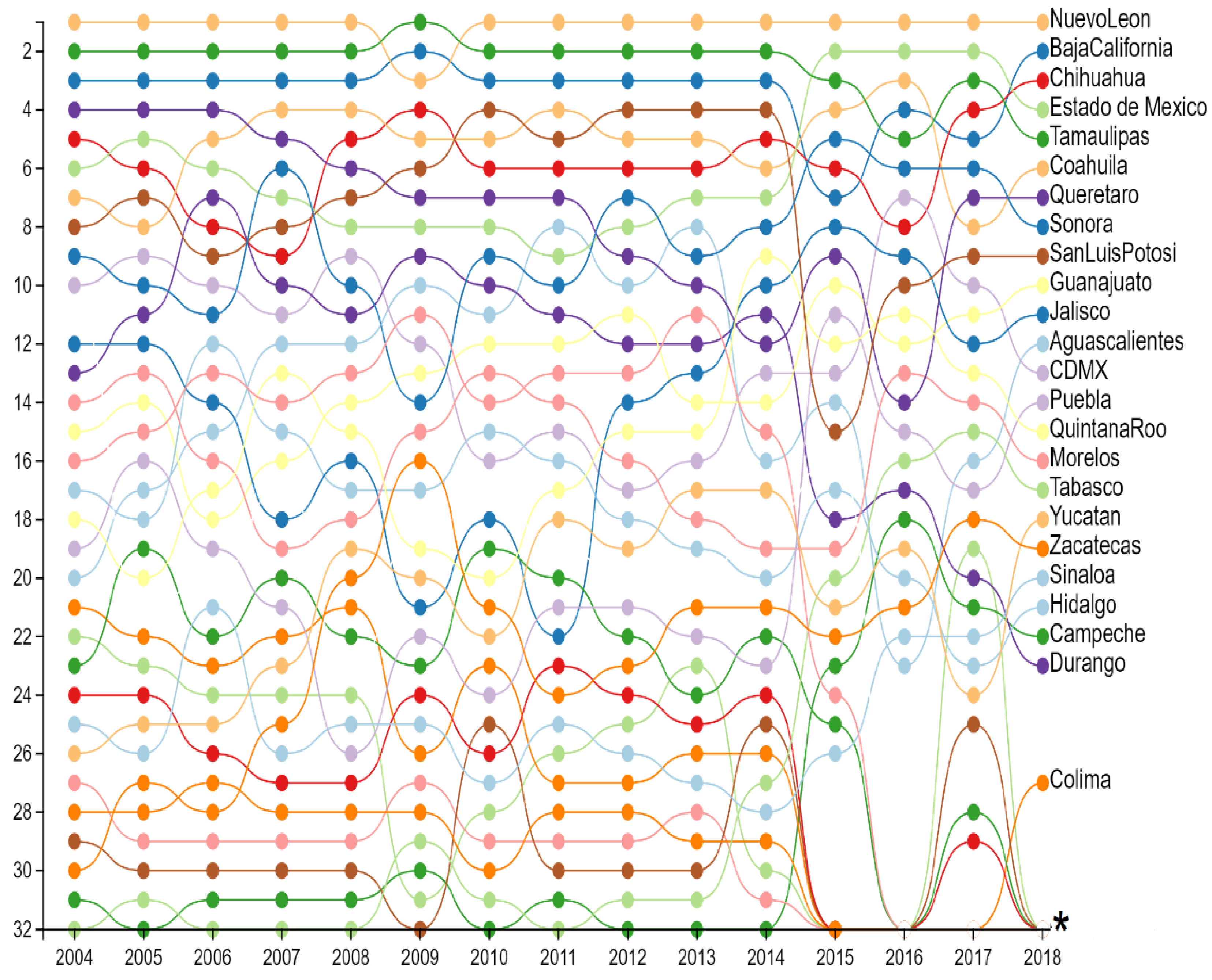
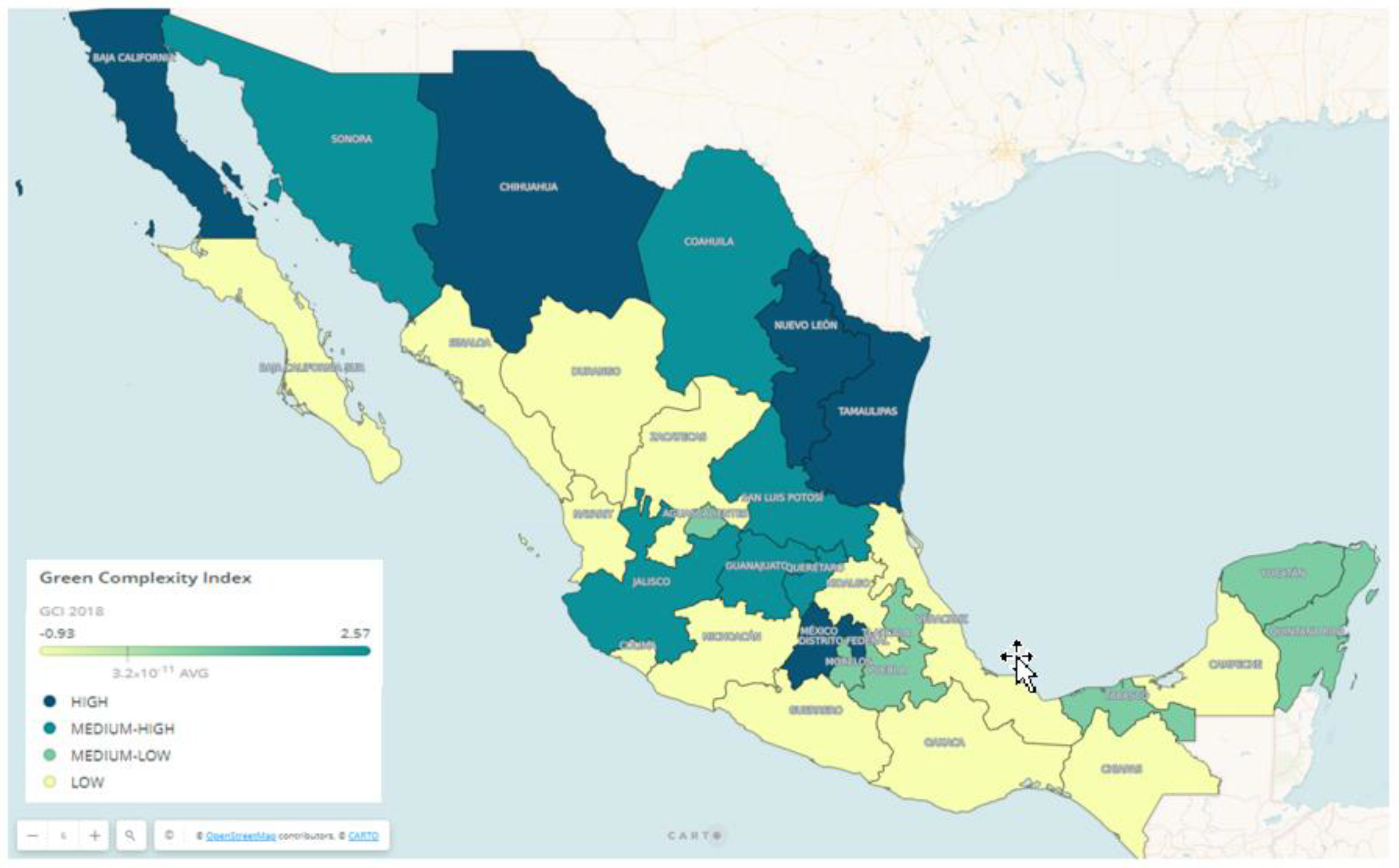
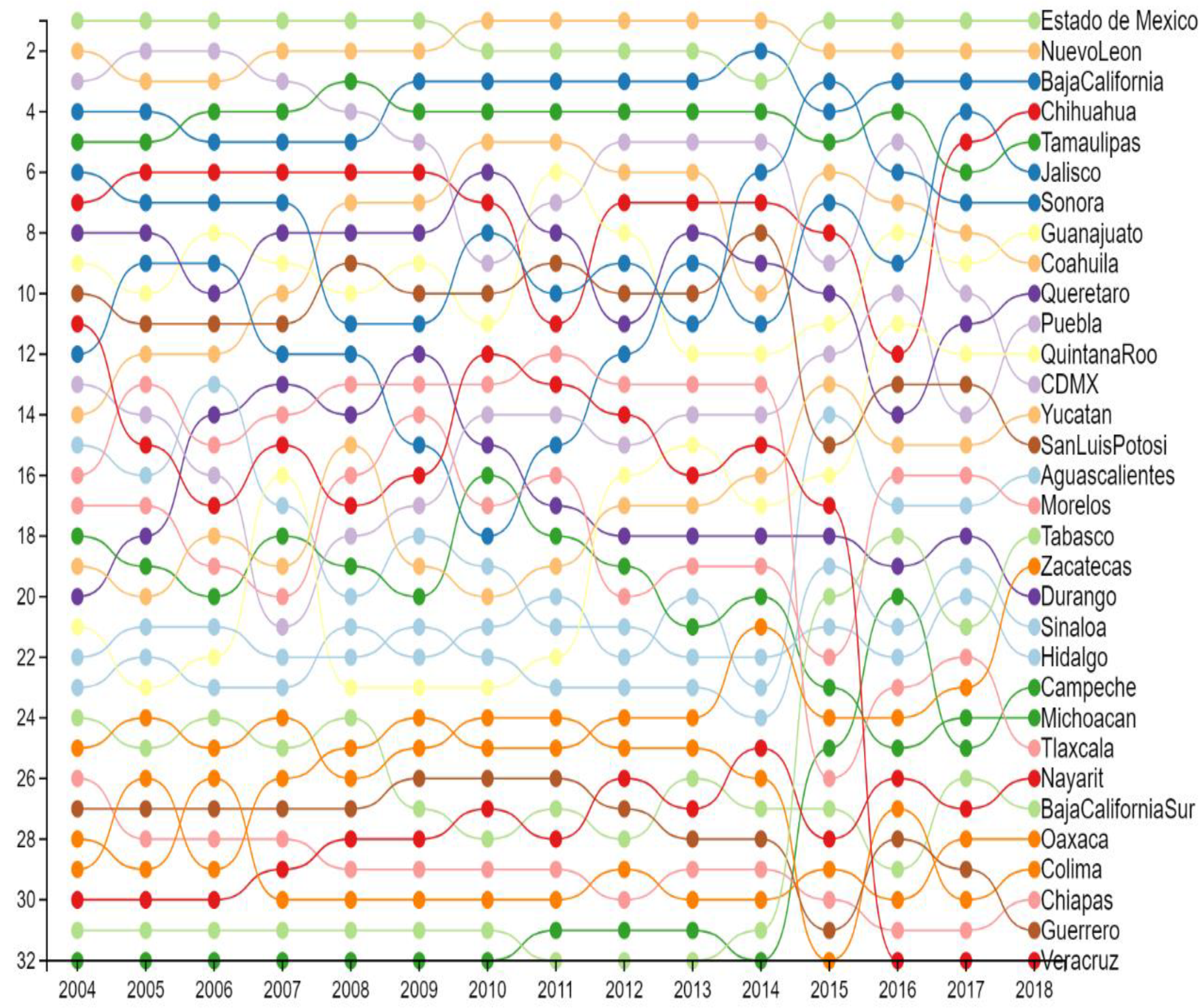
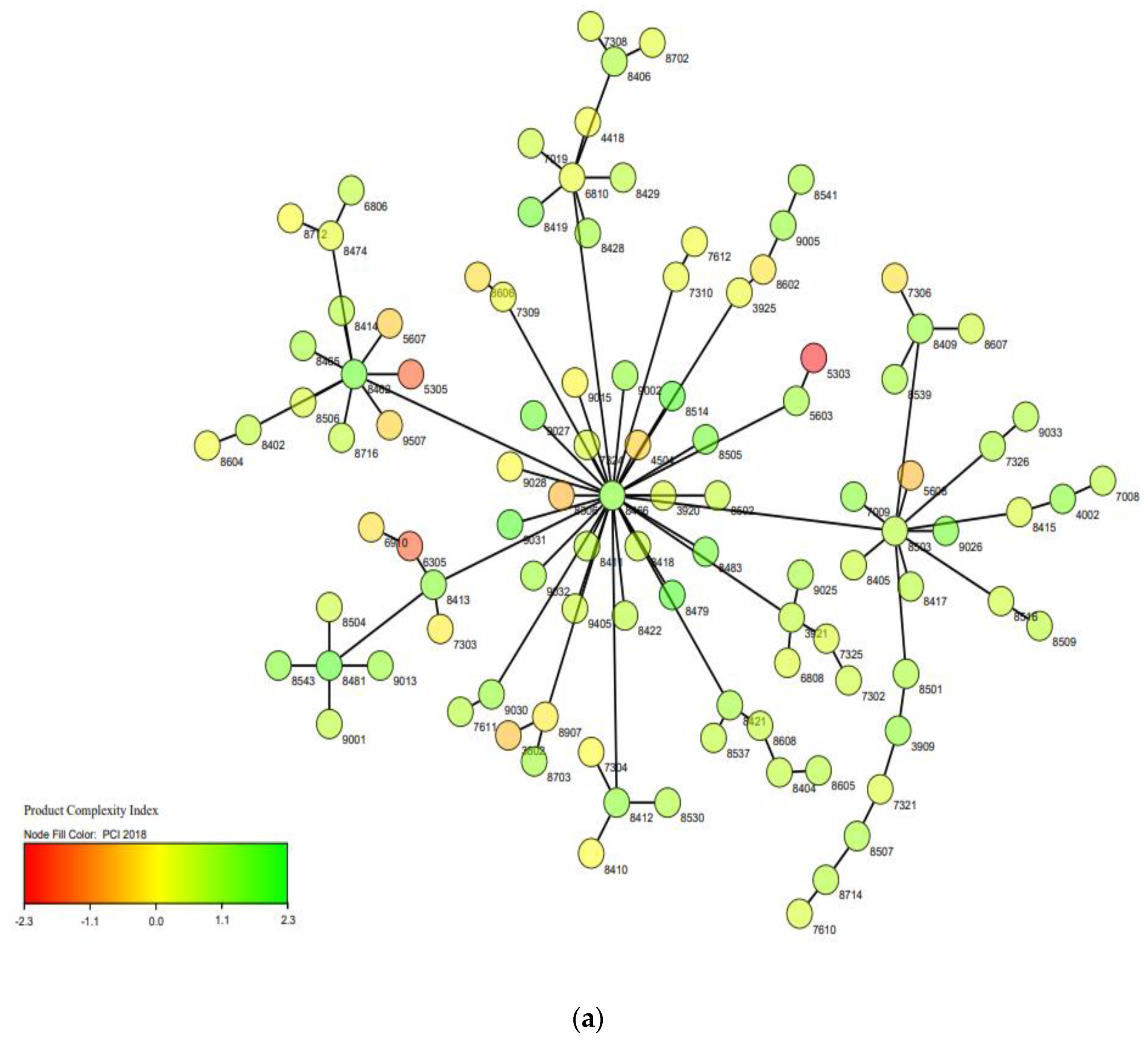
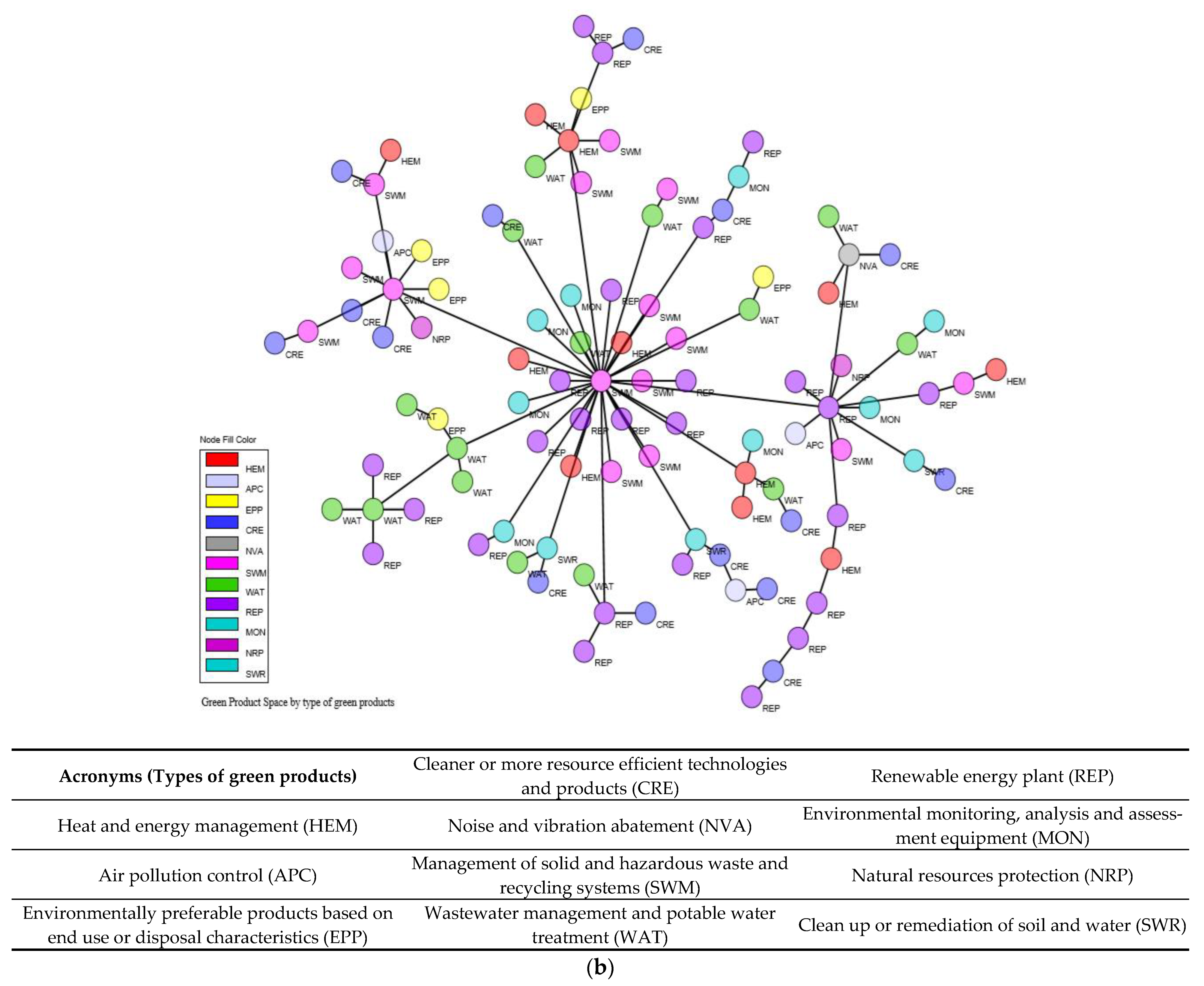

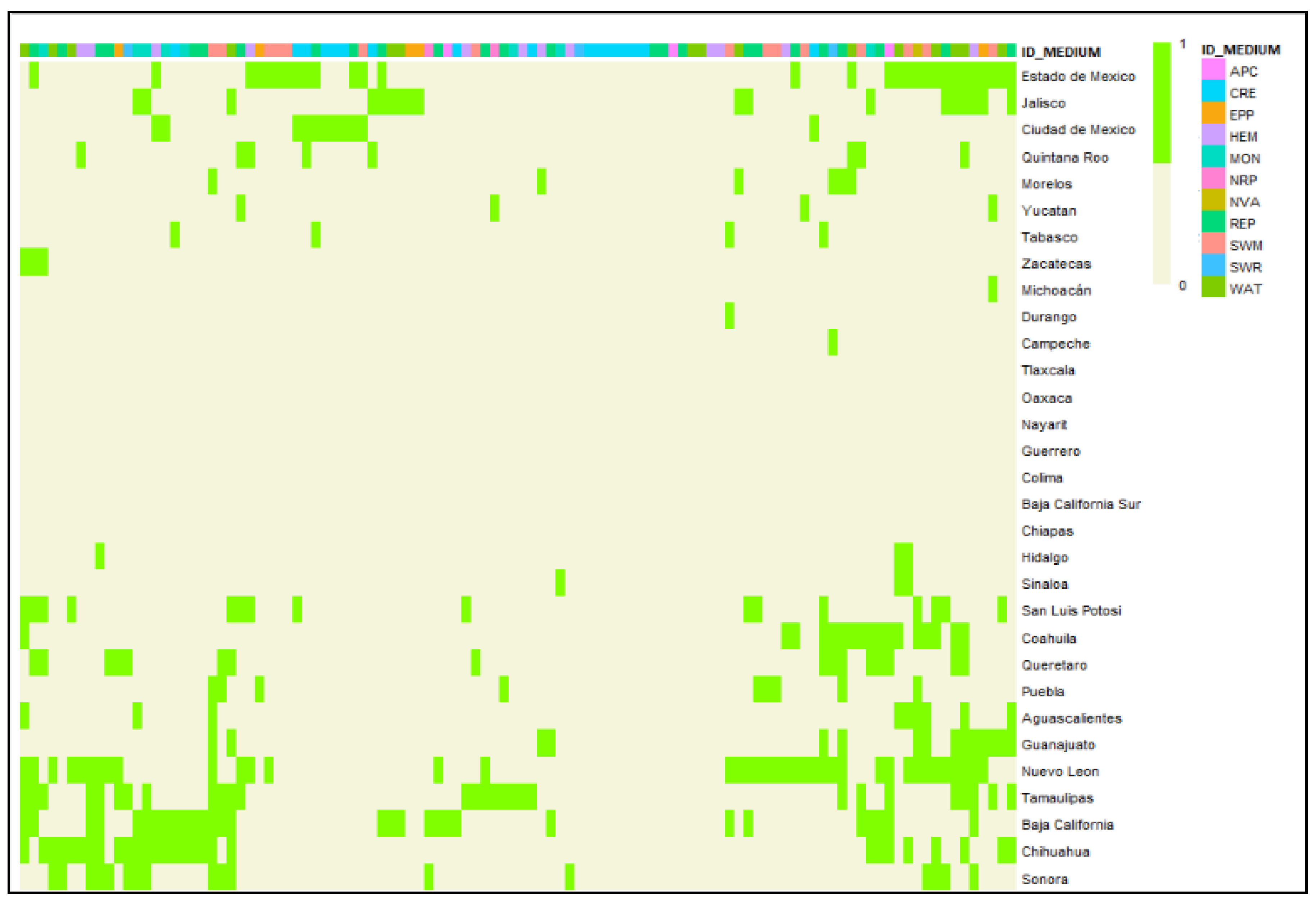
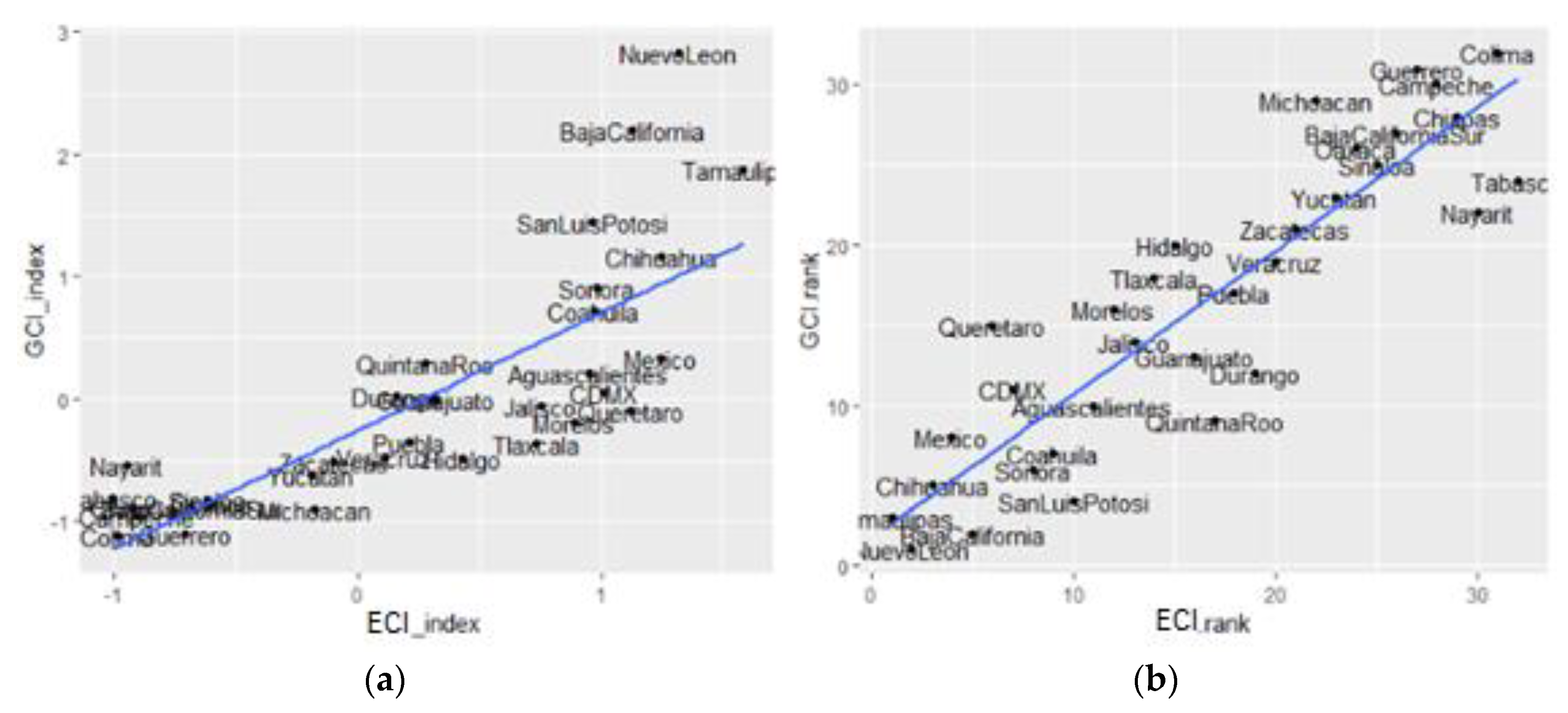
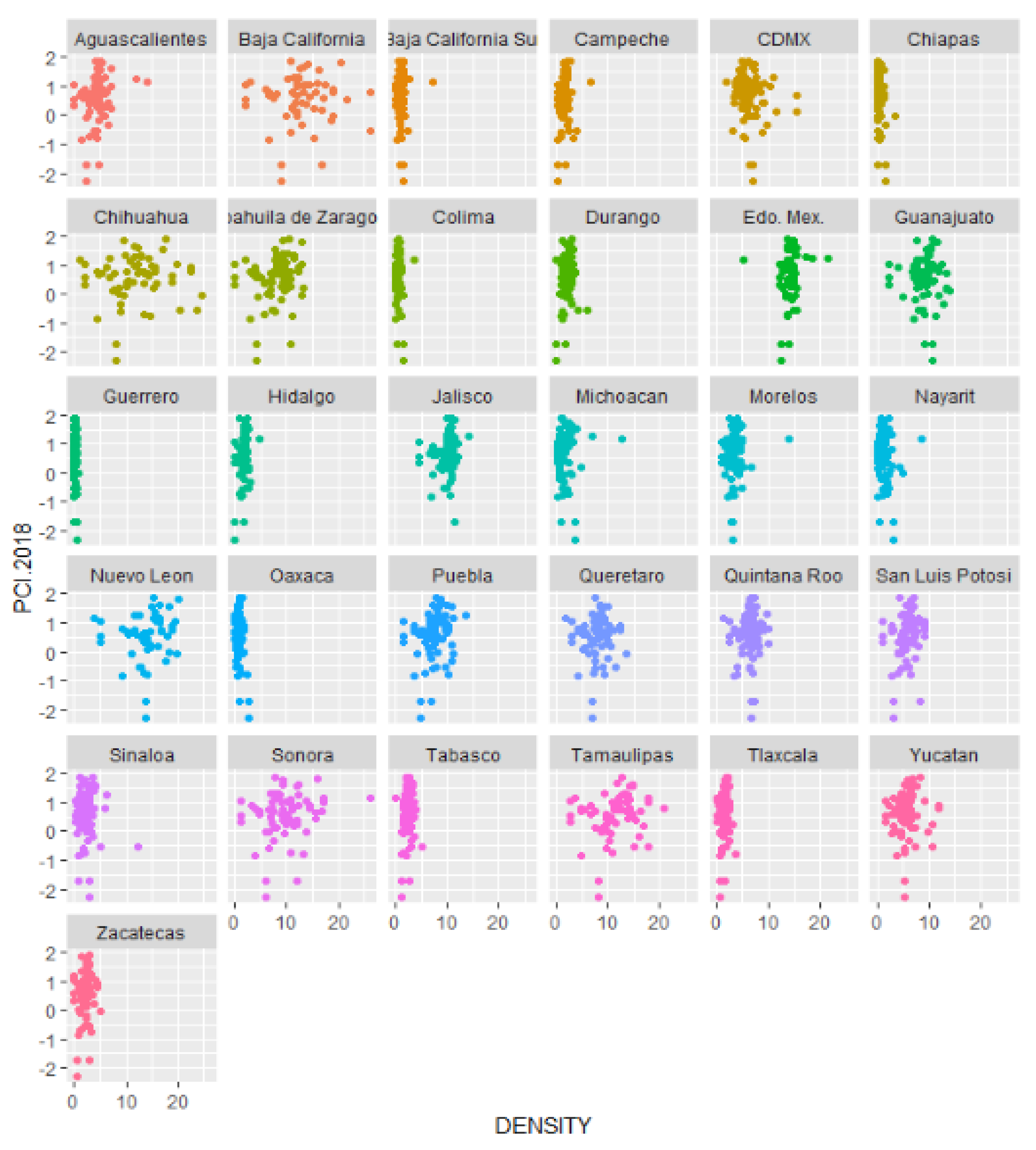
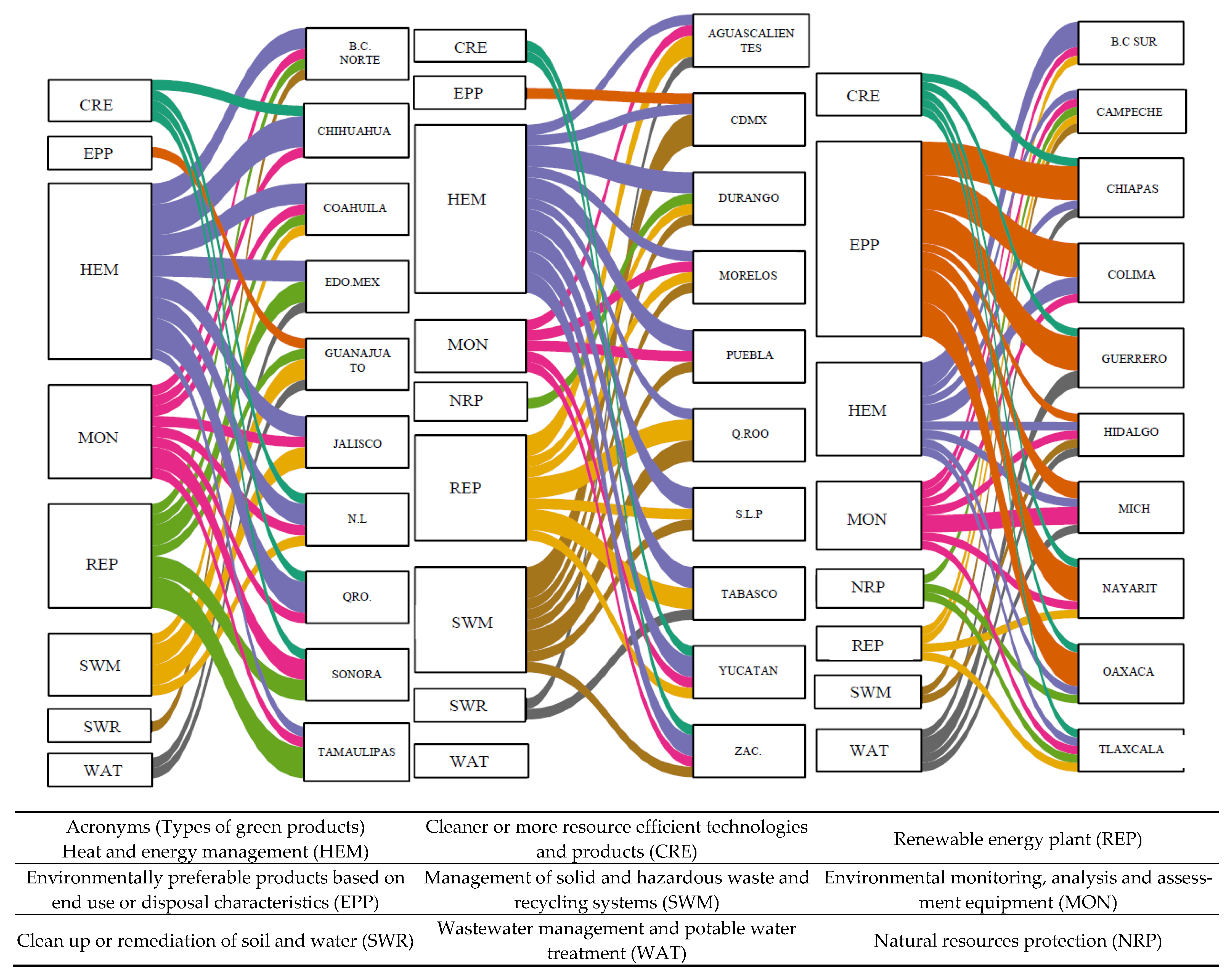
| (1) The Hierarchical Structure of the Standard Industrial Classification (SIC) System. | (2) The Co-Occurrence Approach Proposed by Hidalgo et al. | (3) The Similarity in Resource Use |
|---|---|---|
| Definition | ||
| The method based on similarities in upward and down- ward linkages in input-output tables. The closer together industries are within this classification system, the more related they are thought to be. | Co-occurrence analysis measures the relatedness between two industries by assessing whether two industries are often found together in one and the same economic entity. Hidalgo et al. counted the number of times that two industries showed a revealed comparative advantage (the co-occurrence) in the same country (the economic entity). | The third approach defines relatedness through similarity in resource use or flow of resources between firms and/or sectors focusing on the role of human capital and the similarity in occupation profiles, technological resources using patent analysis, and material resources using commodity flows measured through input–output linkages. |
| Limitation (bias) | ||
| This method is relatively easy to implement and available for a large number of secondary data for different countries and regions. However, the method has been critiqued for neglecting the relatedness between subsectors that do not belong to the same sector classification. | However, other factors besides relatedness may partly determine the number of co-occurrences. For example, if industries are very large, they are likely to be found in many firms, and, therefore, they will also more frequently co-occur with other industries. | Resource-based similarity measures suffer from bias because of the strategic relevance given to some resources. Patent-based indicators shed light on relatedness among patent-intensive industries, while input–output-based measures may be more useful for an investigation of manufacturing rather than service industries. |
Publisher’s Note: MDPI stays neutral with regard to jurisdictional claims in published maps and institutional affiliations. |
© 2021 by the authors. Licensee MDPI, Basel, Switzerland. This article is an open access article distributed under the terms and conditions of the Creative Commons Attribution (CC BY) license (http://creativecommons.org/licenses/by/4.0/).
Share and Cite
Pérez-Hernández, C.C.; Salazar-Hernández, B.C.; Mendoza-Moheno, J.; Cruz-Coria, E.; Hernández-Calzada, M.A. Mapping the Green Product-Space in Mexico: From Capabilities to Green Opportunities. Sustainability 2021, 13, 945. https://doi.org/10.3390/su13020945
Pérez-Hernández CC, Salazar-Hernández BC, Mendoza-Moheno J, Cruz-Coria E, Hernández-Calzada MA. Mapping the Green Product-Space in Mexico: From Capabilities to Green Opportunities. Sustainability. 2021; 13(2):945. https://doi.org/10.3390/su13020945
Chicago/Turabian StylePérez-Hernández, Carla Carolina, Blanca Cecilia Salazar-Hernández, Jessica Mendoza-Moheno, Erika Cruz-Coria, and Martín Aubert Hernández-Calzada. 2021. "Mapping the Green Product-Space in Mexico: From Capabilities to Green Opportunities" Sustainability 13, no. 2: 945. https://doi.org/10.3390/su13020945
APA StylePérez-Hernández, C. C., Salazar-Hernández, B. C., Mendoza-Moheno, J., Cruz-Coria, E., & Hernández-Calzada, M. A. (2021). Mapping the Green Product-Space in Mexico: From Capabilities to Green Opportunities. Sustainability, 13(2), 945. https://doi.org/10.3390/su13020945






